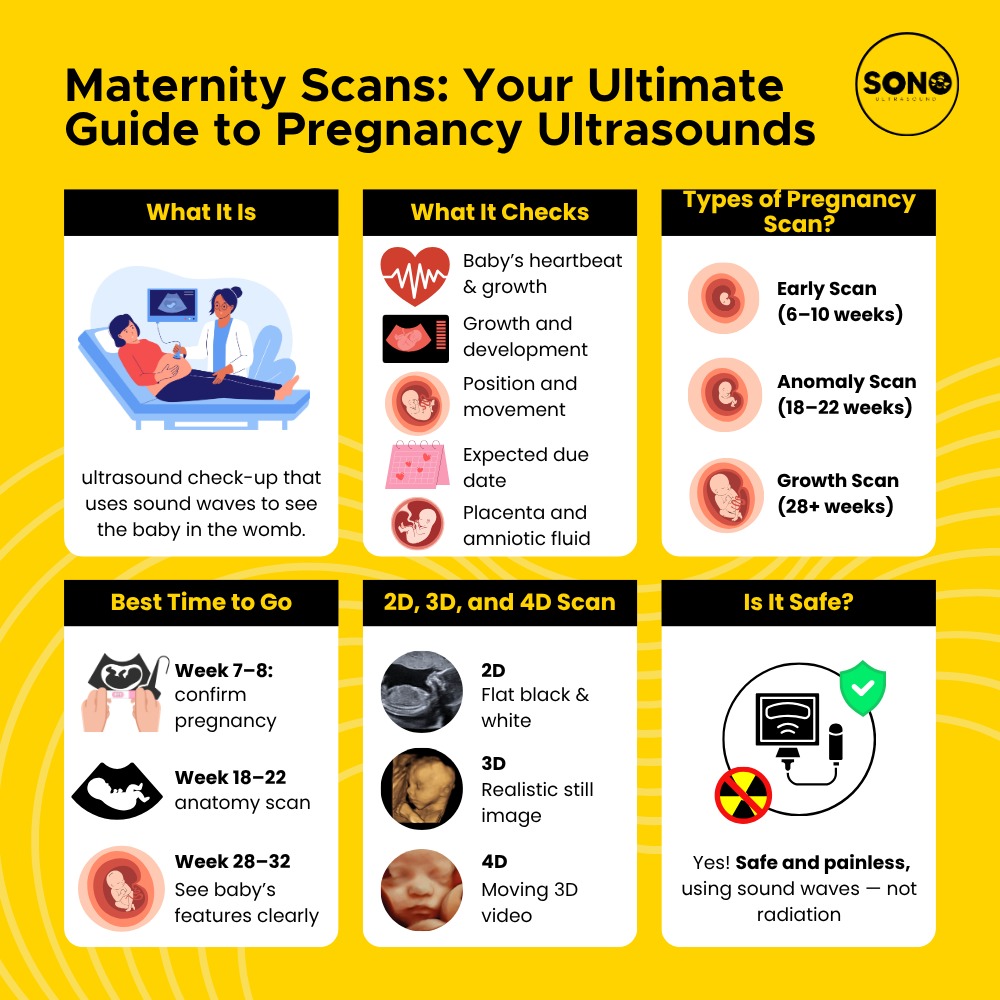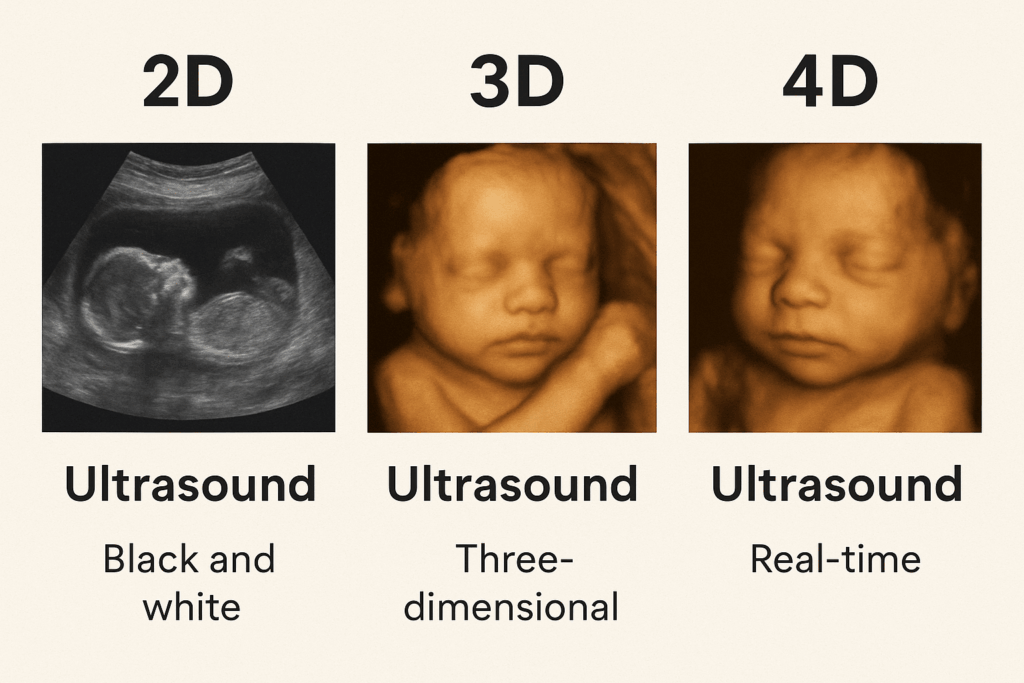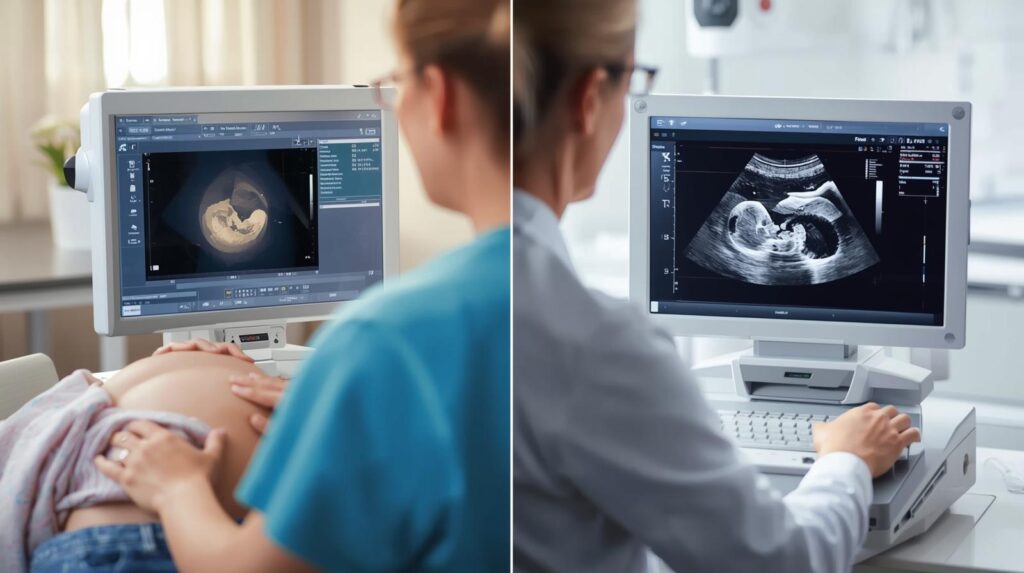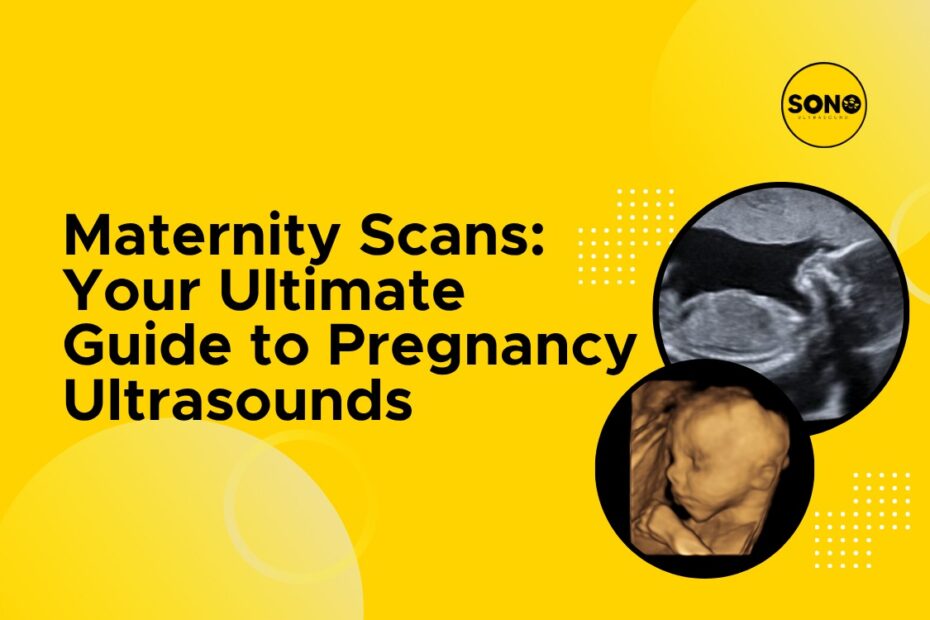A pregnancy scan, or ultrasound, is a medical procedure that uses sound waves to create images of the fetus, womb, and other pelvic organs. It is used to confirm pregnancy, check fetal development, and assess overall maternal and fetal health. Scans can be done at various stages, including early scans to confirm a viable pregnancy and a more detailed 20-week anomaly scan to check for abnormalities. For expectant parents, this process is a pivotal milestone—a first glimpse of their baby and a profound moment of reassurance. But beyond the emotional magic, a maternity scan is a critical piece of prenatal care, providing invaluable medical insights.
This ultimate guide is designed to demystify the entire process. We will explore what a maternity scan truly means, the different types available, their safety, and what you can expect at each stage of your pregnancy.
What is the Meaning of a Maternity Scan?
A maternity scan, more commonly known as a pregnancy or fetal ultrasound, is a non-invasive medical imaging procedure. It uses high-frequency sound waves—not radiation—to create images of your developing baby, placenta, uterus, and other pelvic organs. These sound waves bounce off tissues and fluids, and the returning echoes are translated by a computer into real-time visual images on a monitor.

In essence, a maternity scan is a window into the womb. It serves two primary purposes:
A Diagnostic Tool: It provides your healthcare team with essential data to monitor fetal development, confirm dates, screen for potential conditions, and assess your health.
A Bonding Experience: It offers parents an incredible opportunity to see their baby move, hear the heartbeat, and forge an early emotional connection.
What Information Can Be Obtained from a Maternity Scan?
The information gleaned from a scan is extensive and varies depending on the trimester. It is far more than just a first photo; it’s a comprehensive health check that can:
- Confirm the Pregnancy: Verify the presence of a gestational sac and embryo within the uterus, accurately ruling out an ectopic pregnancy.
- Determine Gestational Age and Due Date: By measuring the baby from crown to rump (CRL), the sonographer can establish an accurate due date, which is crucial for tracking growth.
- Confirm a Fetal Heartbeat: Visualizing and hearing the steady rhythm of the baby’s heart is a key sign of viability and provides immense reassurance.
- Identify Multiple Pregnancies: Determine if you are carrying twins, triplets, or more.
- Assess Fetal Growth and Anatomy: Measurements of the head (BPD), abdomen (AC), and femur bone (FL) ensure the baby is growing appropriately. Detailed scans examine the brain, heart, spine, limbs, and major organs.
- Screen for Fetal Abnormalities: The anomaly scan is specifically designed to detect potential structural issues like spina bifida, heart defects, or cleft lip.
- Check Placental Position and Health: The scan locates the placenta to rule out placenta previa, a condition where it covers the cervix.
- Assess Amniotic Fluid Levels: It ensures there is a healthy amount of amniotic fluid, which is vital for the baby’s development, movement, and lung development.
- Determine Fetal Position: Later in pregnancy, scans confirm if the baby is in a head-down (cephalic), breech, or transverse position, which influences birth planning.
How Many Types of Pregnancy Scans Are There?
While the schedule can vary, pregnancies typically involve a series of standard scans, often categorized by trimester. Additional, specialized scans may be recommended if you are deemed to have a high-risk pregnancy.
- First-Trimester Scans (Weeks 6-13):
- Early Viability/Dating Scan: Often the first scan, it confirms the pregnancy is in the uterus, establishes the due date, and confirms the heartbeat.
- Nuchal Translucency (NT) Scan: Performed between 11 and 14 weeks, this is part of a combined screening test for Down’s syndrome and other chromosomal conditions. It measures the fluid at the back of the baby’s neck.
- Second-Trimester Scans (Weeks 18-22):
- Anomaly Scan (or 20-Week Scan): This is a detailed, comprehensive examination of the baby’s anatomy from head to toe. It’s a systematic check of all major organs and structures.
- Third-Trimester Scans (Weeks 28+):
- Fetal Well-being and Growth Scans: These are not routine for all pregnancies but are offered if there are concerns such as the baby measuring too small or too large, reduced fetal movements, or issues with the placenta or amniotic fluid.
Specialized scans like Doppler ultrasounds to assess blood flow in the umbilical cord and baby’s vessels, or fetal echocardiograms for a detailed look at the heart, may also be used when necessary.
What is the Difference Between 2D, 3D, and 4D Ultrasound?
The “D” stands for dimension, and this is the key differentiator.

2D Ultrasound: This is the standard, black-and-white, two-dimensional workhorse of medical diagnostics. The image may appear flat and grainy to an untrained eye, but it provides exceptional clarity of internal structures. This is the primary technology used for all crucial measurements and anatomical checks. Think of it as a detailed architectural blueprint.
- 3D Ultrasound: This technology takes thousands of 2D image slices and compiles them into a three-dimensional, still image. This gives a more photorealistic view of the baby’s surface features—you can see the contours of the face, hands, and feet. While it can be useful for diagnosing surface abnormalities like a cleft lip, it is often sought after for the enhanced bonding experience. Think of it as a detailed photograph of the finished building.
- 4D Ultrasound: This is 3D ultrasound in real-time, adding the dimension of time. It creates a live video effect, allowing you to see the baby moving, yawning, stretching, or sucking its thumb. 4D scans are typically offered by private clinics for bonding and are not used as a primary diagnostic tool. Think of it as a live video stream of the building.
Crucial Takeaway: Your essential medical scans will be performed using 2D technology. 3D and 4D are wonderful supplements for emotional connection but do not replace the diagnostic power of a 2D scan.
Is it Safe to Have an Ultrasound Scan?
Yes. Decades of extensive use and research have found ultrasound to be a very safe procedure with no known harmful side effects when used appropriately by trained healthcare professionals. Unlike X-rays or CT scans, it does not use ionizing radiation.
The sound waves used are of very low intensity. Major medical bodies worldwide, including the American Institute of Ultrasound in Medicine (AIUM) and the World Health Organization (WHO), endorse its safety for medical purposes. However, they caution against the non-essential, “keepsake” use of 3D/4D ultrasounds at private boutiques, where sessions can be prolonged and performed without a medical goal.
What Are the Best Weeks for an Ultrasound Scan?
Timing is critical for each scan to gather the most accurate information.
- Dating Scan: Weeks 7-10 is ideal. Before 7 weeks, it may be too early to see much; during this window, the baby’s size is perfect for an accurate due date measurement.
- Nuchal Translucency Scan: Must be performed between Weeks 11 and 13+6—this is a very time-sensitive measurement.
- Anomaly Scan: Routinely scheduled between Weeks 18 and 22, with Week 20 often being the ideal time as the baby is large enough to see details but still has room to move.
- Growth Scans: These are performed as needed in the third trimester, typically from Week 28 onwards.
How Many Scans Are Taken During Pregnancy?
For a low-risk, uncomplicated pregnancy, most women will have at least two scans: the dating/NT scan in the first trimester and the anomaly scan in the second. However, the total number can easily be higher. You may have an early scan at 6 weeks if there is bleeding or pain, and you may have additional growth scans in the third trimester if your midwife or doctor has any concerns. There is no fixed “one-size-fits-all” number.
Book your ultrasound appointment for peace of mind.

Can I Refuse Pregnancy Scans?
Yes. Ultrasound scans are a recommended and vital part of prenatal care, but they are voluntary. You have the right to refuse any or all scans based on personal choice. This is a deeply personal decision.
However, it is crucial to have an informed discussion with your healthcare provider about the benefits of the scan and the potential implications of declining it. Forgoing a scan means you will not have access to the important medical information it provides, which could be critical for managing your and your baby’s health.

When Are Ultrasound Scans Offered During Pregnancy?
The standard schedule in many healthcare systems is:
- First Trimester: Around 8-14 weeks for the dating and/or NT scan.
- Second Trimester: Around 18-21 weeks for the anomaly scan.
Any additional scans will be scheduled based on your individual clinical needs and the policies of your local health service.
Who Performs an Ultrasound Scan During Pregnancy?
A specialist healthcare professional called a sonographer (or ultrasonographer) typically performs the scan. Sonographers are highly trained in operating the ultrasound machine and capturing the precise images and measurements required.
The images are then often reviewed by a Radiologist or a Fetal-Maternal Medicine Specialist (a doctor who specializes in high-risk pregnancies), who provides the final official diagnosis and report to your referring obstetrician or midwife. In some cases, your obstetrician may also be trained to perform ultrasounds.
What Are the Benefits of Having This Ultrasound?

The benefits are both clinical and emotional:
- Reassurance and Peace of Mind: Confirming a healthy, progressing pregnancy is invaluable for expectant parents.
- Early Detection and Intervention: Allows for the identification of potential problems, enabling management in utero or planning for specialized care after birth.
- Accurate Pregnancy Dating: Essential for monitoring growth and planning for delivery.
- Enhanced Bonding: Seeing your baby move and hearing their heartbeat makes the pregnancy feel more real and strengthens the parental connection.
- Informed Decision-Making: Empowers you and your healthcare team with the knowledge needed to make the best choices for your pregnancy and birth plan.
When Will I Get the Results of My Ultrasound Scan?
In the vast majority of cases, the sonographer can give you immediate, preliminary feedback. They can point out the heartbeat, show you the baby’s major parts, and tell you if everything appears as expected from a visual standpoint. They will usually tell you if they have any immediate concerns.
However, the formal report, which includes all the detailed measurements and a final analysis, is written by a reviewing doctor. This report is then sent to your referring obstetrician or midwife, a process that can take a few days to a week. You will typically discuss the full, formal results at your next scheduled prenatal appointment. If an urgent issue is found, you will be informed immediately before you leave the department.
10 Frequently Asked Questions (FAQs) About Maternity Scans
- Do I need a full bladder for the scan?
For early pregnancy scans (before 12 weeks), a full bladder is essential as it pushes the uterus up and provides a clearer “acoustic window.” For the 20-week scan, it’s often less critical, but always follow your clinic’s specific instructions. - Can I find out the baby’s sex at the scan?
Yes, the anomaly scan (around 20 weeks) can often determine the baby’s biological sex, but it is not 100% accurate. The baby needs to be in a favourable position. You must inform the sonographer at the start if you wish to know. - What if the scan finds a potential problem?
Try not to panic. If a potential issue is detected, you will be referred to a specialist, such as a Fetal-Maternal Medicine consultant, for further, more detailed scans and counseling to discuss the findings, what they mean, and your options. - Why might I need a transvaginal scan?
In early pregnancy, a transvaginal (internal) scan uses a slender probe that gets closer to the uterus, providing a much clearer image than an abdominal scan can at that stage. It is safe, not typically painful, and provides the best diagnostic information early on. - My friend had more scans than me. Should I be worried?
No. The number of scans is tailored to each individual pregnancy. More scans are often required for monitoring specific conditions (e.g., twins, high blood pressure, gestational diabetes), not because it’s “better.” Fewer scans usually indicate a low-risk, progressing-as-expected pregnancy. - Can I have a copy of the ultrasound pictures?
Most clinics will happily print a few images for you to take home. Some now also offer digital copies on a USB drive or via a secure patient portal. There may be a small fee for this service. - Is the ultrasound gel cold?
Many clinics now use warming cabinets for the gel, so it’s often quite comfortable. However, it can sometimes feel a little cool. It is water-based, hypoallergenic, and wipes off easily after the scan. - Can I bring my family to the scan?
Absolutely. Most hospitals and clinics encourage you to bring one or two support people (e.g., your partner, a parent) to share in the experience. It’s always best to check the clinic’s policy in advance. - What if my baby is in a bad position during the scan?
This is extremely common. The sonographer is an expert at encouraging babies to move. They may ask you to jiggle your belly, go for a short walk, empty your bladder, or lie in a different position. - Are private 3D/4D scans worth it?
This is a personal choice. While they offer a unique and memorable bonding experience, it is essential to choose a reputable clinic with qualified medical sonographers. Remember that these are for entertainment and should never be used as a substitute for your medically indicated diagnostic scans.
Conclusion
Maternity scans are a beautiful fusion of advanced science and profound human emotion. They are a safe, effective, and essential component of prenatal care, providing the roadmap for a healthy pregnancy. By understanding the purpose and process behind each scan, you can approach these appointments not with anxiety, but with confidence and excitement, ready to witness the incredible miracle of your growing baby.
Feeling informed and ready for your appointment? Schedule your maternity scan with our expert team today and experience the reassurance of professional, caring care.
As low as RM18 only.
